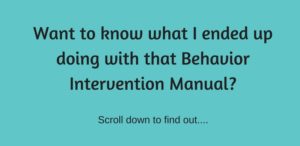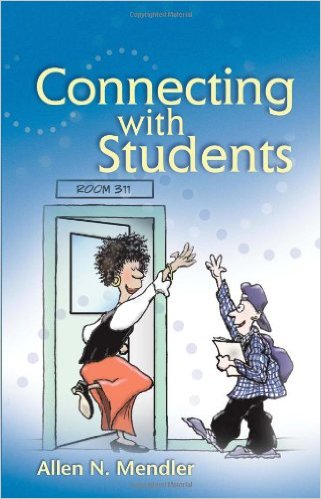When I was a new teacher, my principal gave me a 768-page book called Behavior Intervention Manual. It contained hundreds of strategies for changing students’ troublesome behavior. “Does it have all the answers?” I asked the principal.
“Just read it,” she said.
As if.
Fortunately I found something better. Connecting with Students, by Allen N. Mendler is a 92-page book that changed my teaching life forever.
Just What I Needed
Around that time, I had a student I will call Beatriz (not her real name). Beatriz was a tough girl and I had a tough time being her teacher.
Everything out of her mouth was negative: the way she insulted and taunted others, the way she she laughed at their mistakes and embarrassments, and the way she talked back to me nearly daily without displaying a shred of respect or regret. Though the rest of the students weren’t angels, Beatriz was definitely the most challenging of the bunch.
I tried all the hard-handed discipline moves: warning her, keeping her for detention, sending her to the dean of discipline.
Upon reflection, these “interventions” only increased her animosity towards me, and the cycle repeated itself at increasingly volatile levels.
A Better Approach to Classroom Discipline and Relationships
Mendler’s book was the right resource at the right time. His practical strategies helped me change my perspective about Beatriz. Instead of seeing her as a problem to fix, I began to empathize with her.
After she told another adult on campus that she had “seen things no one should ever see,” I remember feeling sad for her and gaining new understanding and compassion. After all, she was an eighth-grader – still just a child.
I began to soften a bit. Instead of seeing her (as Mendler says) “as the worst of the worst” I began to recognize her as someone with resilience who was trying to “defend [her]self against a hostile world that has tried to take advantage of” her (page 19).
At the same time, I considered the situation of my own nine-year-old niece who I loved so much. She had been through a lot of hard times in her young life and had become difficult at home, at school, and with me.
I hated the idea that my niece’s teacher might view her like I viewed Beatriz: a headache, a problem student who I wished would go away. What if I knew Beatriz’s story like I knew my niece’s story? I would have to act differently.
Beatriz wasn’t going to change quickly or easily. But with support and strategies from Mendler’s book, I was able to begin to think of her as a young person with a lot of pain and anger instead of someone who made trouble in my classroom.
In other words, I began to empathize with her and as a result, there were fewer days with explosions and the overall pitch of our interactions was lower.
This is not a story about a miraculous breakthrough, but about small shifts that have helped me humanize my students, and feel calmer and more humane in the process. These shifts have benefited my relationships with all my students, not just those who were testing my authority, or acting out in some ways.
While this book also does not contain “the answers,” it did suggest a framework for altering my perspective.
Connecting With Students – A Book Review
Mendler’s basic tenet is that instead of waiting to connect with a student when we realize she is in need, we can proactively implement practical and specific strategies as part of our ongoing teaching practice – rather than reacting with “behavior intervention.” Best of all, the strategies place a high value on relationships which always makes me happy.
This is a thin volume. But each time I re-read sections of this book (which I do frequently), it takes me a long time. I say this not because the book is boring, but because it is so poignant that I need to sit and think about almost every point. It’s one of those books that feels like it was written with me (and maybe you) in mind.
The book includes a smorgasbord of short, easy to implement ideas. This enables teachers to pick those that feel most authentic and try a few out on a consistent basis. Here are some of my favorites:
- Choose a student that really gets your goat. Commit to investing “two uninterrupted, undivided minutes a day for 10 consecutive days” to building a relationship with the student (page 25). I’ve done this by visiting the student at lunch, or having the student help me before or after school. They key is to not discuss school at all.
- Give occasional “positive” notes to an improving student to deliver to their parent or guardian, shortly after they have done something inappropriate. In other words, I write a general note praising the student (“I really appreciate the way you helped your partner,” or “Thanks for getting to class early and having all your supplies out before the bell rang.”). Then, at the moment the student does something unacceptable, I walk by and drop the note on the desk. I love seeing their face when they think they are getting a “you’re busted” note – only to see that I’ve communicated something positive about them (page 29).
- Answer three “life” questions each day that have nothing to do with your content, but are are of interest to your students: your hobbies, family, and – my students’ favorite – what you were like when you were their age (page 57).
Specific Classroom Ideas You Can Implement Tomorrow
When I say his strategies are “specific,” I mean it. He describes each clearly in a paragraph or two, and often gives sample conversation to give the reader a concrete example to illustrate the strategy.
I have turned to this small book many times to re-frame the maddening behavior of challenging students. These are some of the passages in the section on called “Necessary Attitudes and Feelings” that I have highlighted, underlined and annotated over and over, including:
- “We must suspend our conventional thinking …if we are to be a positive influence on students who say or do things that make us feel disappointed, angry or frightened” (page 12).
- “Students who present themselves as defiant, obnoxious or distant are unlikely to let go of those behaviors easily…It takes greater persistence, guided by optimism, to break through these barriers of perceived safety to develop the bonds of trust” (page 16).
- As teachers, we have a great opportunity to make a difference in the lives of our students. But sometimes we are distracted by pacing plans, Common Core State Standards, high stakes testing, and parts of our job that steal our time and stress us out.
At those times, it’s easy to forget why we are here. Mendler’s book can help us remember, and give us some practical strategies for building stronger relationships with our students.
Here’s What I Did With My Principal’s Suggestion
The book my principal gave me now props up my laptop stand.
Want to know more about that laptop stand and other equipment and tools I use? Check out my Resources Page.
Like this post? How about subscribing to this blog?
Want more like this? Check out my blog post about proactively loving our students by clicking here. It fits right into Allen N. Mendler’s philosophy.




Leave A Response